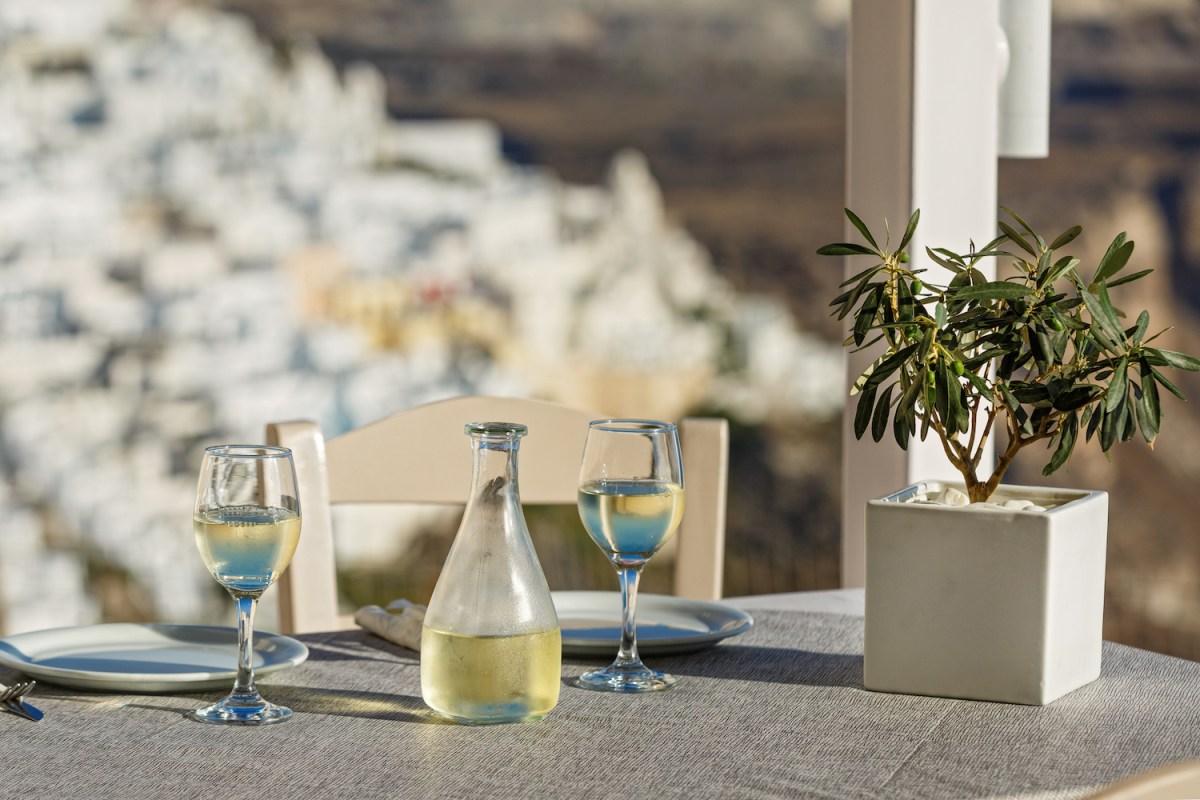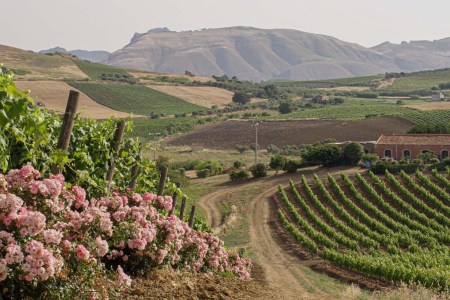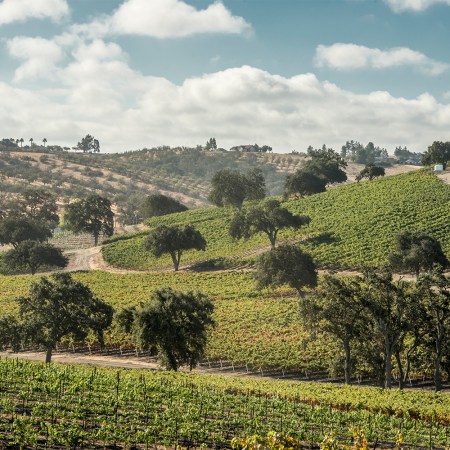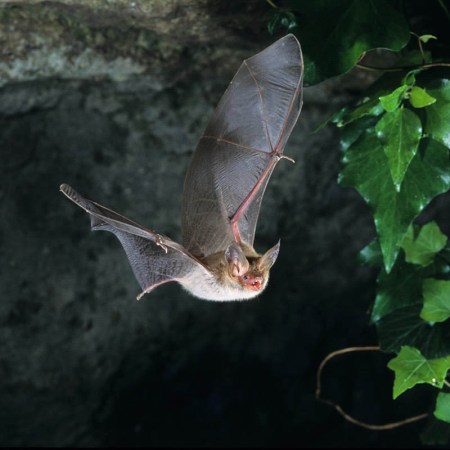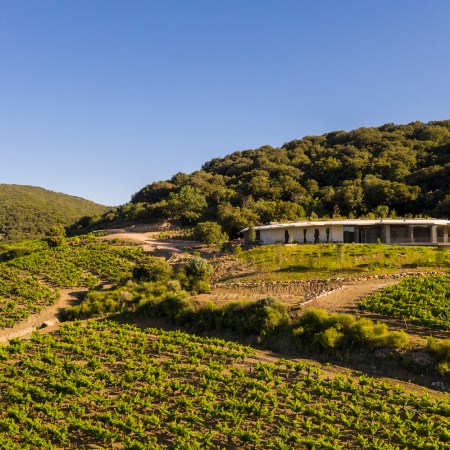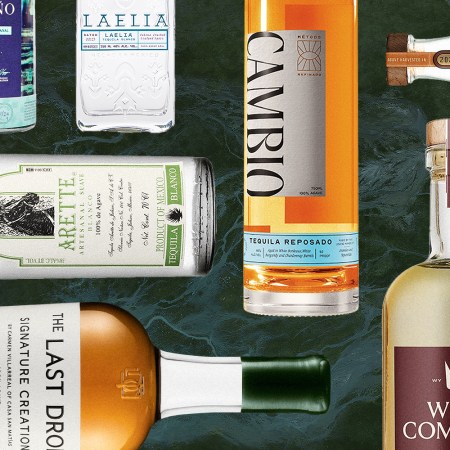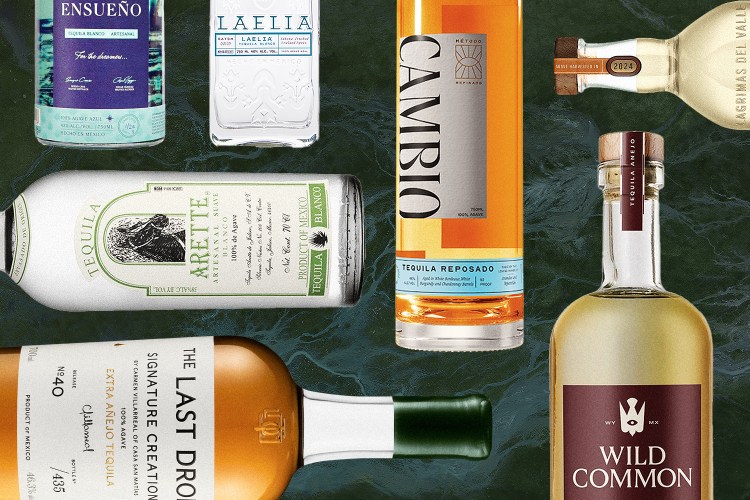If mentions of historic vineyards and the winemaking tradition transport your mind to France, gently inform it to stay south before heading east — all the way over to the Mediterranean nation of Greece. Winemaking has been at the heart of Greek culture from as early as 4300 BC, and though a tumultuous history kept it from gaining the same reputation as neighboring Italy, six millennia of practice and cultivation have led to some pretty damn good wine.
One of the best and most unexpected places to experience Greek winemaking is the picturesque island of Santorini, a popular summer destination that is often grouped together with a visit to nearby Mykonos. While fans of Mykonos love the island for its stunning beaches and iconic nightlife, Santorini’s frequenters are drawn there in part by its bar-none sunsets and charming villages, which cling to the top of majestically precarious cliff sides. But there’s so much more to Santorini than meets the eye (and the camera lens), namely in the realm of oinos, or wine.
An Explosion (of Flavor)
Those familiar with wine linguistics will know all about terroir and how the natural elements surrounding a vineyard will have a tremendous impact on the finished product. For Santorini wineries, their international star has been rising as more imbibers discover the unique flavors imparted by a dangerous character: the dormant volcano that shaped modern day Santorini, once known as Thera.
A casual 3,500 years ago, Thera erupted, and some historians say it was the largest eruption in recorded history — some even assert that it wiped out the lost civilization of the mythical Atlantis. Since then, it has gone on to erupt 11 more times, forever altering the island’s topography and imparting the soil with basalt, granite, pumice, obsidian and ash.
While that might sound like a disastrous recipe for growing grapes, the acidic soil actually imparts stunning minerality, freshness and a low pH to Santorini’s wines. Today, visitors can find no less than 40 local grape varieties growing on the island with more than 20 wineries and counting.
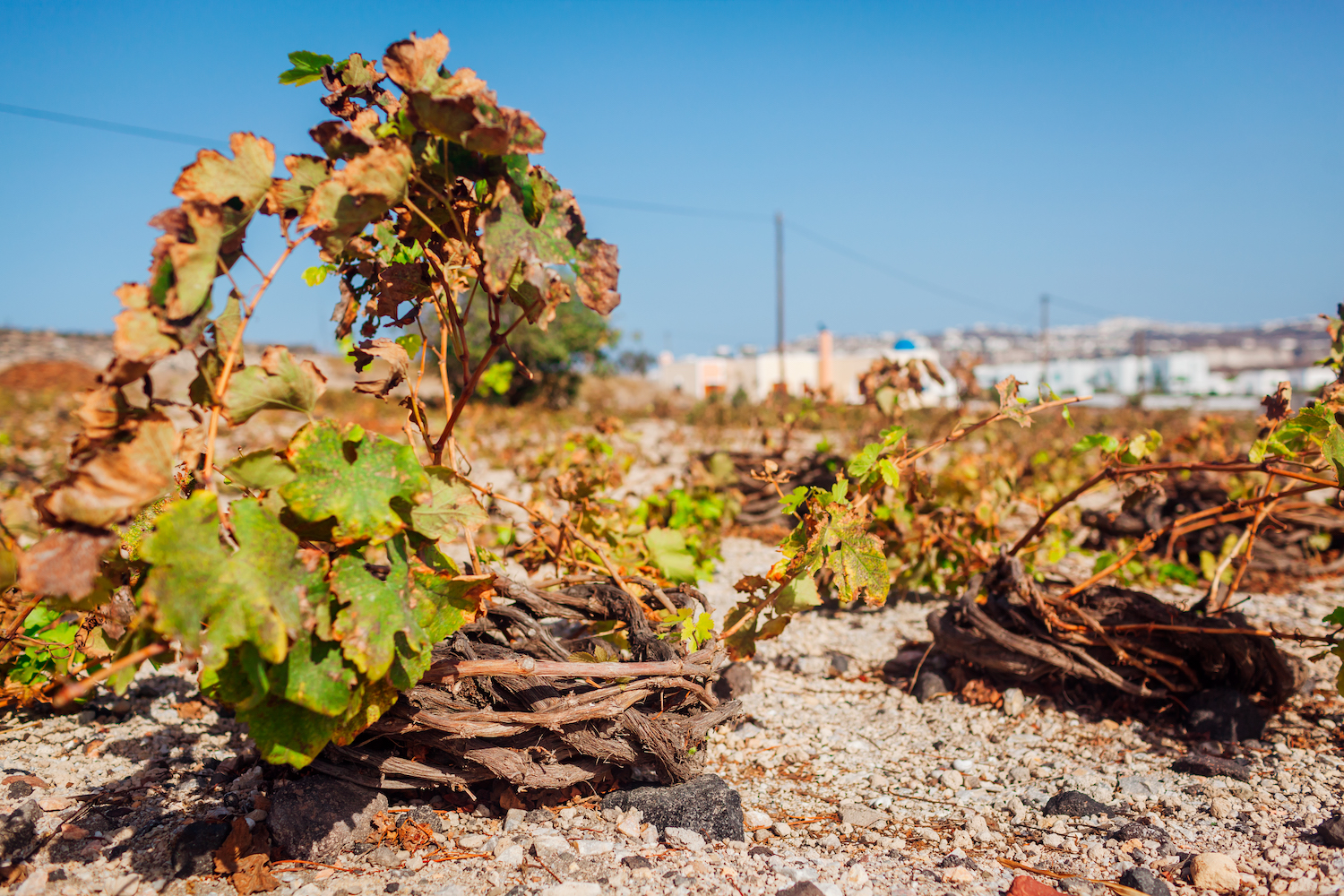
Unique Vines
Santorini is also known for its intense levels of sunlight and violently gusty winds — not necessarily ideal conditions for tender vines and budding fruit. In order to keep the plants safe, wine producers call upon the ancient kouloura method, which involves training vines to coil around themselves like a basket, each sitting neatly atop the rocky soil.
“These traditional basket-shaped vines are unique to the wine world; this training system protects the vines from the fierce winds and from the intense summer sun while creating, at the same time, a much-needed humid microclimate,” says Yiannis Karakasis MW, wine director of Katikies Group and author of The Wines of Santorini. “These vines are part of both the Santorini terroir and the island’s heritage standing still for decades or even centuries.”
While it might sound a little funny compared to how we picture vineyards to look today, ungrafted vines actually used to be the norm throughout Europe. It was only in 1860 that methods quickly and drastically shifted, thanks to the arrival of phylloxera, a pesky louse that lives and feeds on the roots of grapes. But on Santorini, intense climate conditions and an isolated island location have managed to keep phylloxera completely at bay.
Driving around Santorini, you might not even notice the grape vines at first, as they lay coiled safely on the ground. Look a bit closer, though, and you’ll see that they are absolutely everywhere, their fruit ripening up for the picking come August and September.
The Wines and Wonders of Sicily’s West Coast
Tourists have long flocked to the eastern coast, but there’s a pretty strong argument to be made for the other side of the island as wellAcidic Assyrtiko
Once the harvest kicks off, the picked grapes are left to dry in the summer sun for two to three weeks as their flavors, sugars and aromas slowly intensify. The grapes are then taken to the press before making their way into cave-like cellars that are carved into the underground landscape of the island. It’s here that many wineries will lead guided tours and host tastings to give visitors a firsthand glimpse into the world of Santorini wines, which allow them to sample some of the best local grapes like Assyrtiko, Aidani and Vinsanto.
When it comes to Santorini’s wines, Assyrtiko really is the magic word as the island’s flagship grape variety and one that has been grown on the island for 35 centuries, according to Karakasis’ book. Around 60% of the Assyrtiko grown in Greece comes from the small island of Santorini or its tinier volcanic counterpart, Therasia.
Complex, rich in minerality and tinged with salinity from its oceanic surroundings, Assyrtiko is a vastly underrated grape that creates a dry white wine you’ll want to import home by the barrel. The same grape also takes on a very different life as a Vinsanto when left to dry for longer in the Grecian sun, becoming a sweet, strong wine that is sometimes aged in French oak and served as an aperitif. Most of the best wines on the island are made from Assyrtiko or an Assyrtiko-dominant blend, including those hand selected by Karakasis, like Selene Santorini Cuvée Privée 2021. The grapes are sourced from Lakkos and Livadia vineyards in the celebrated Megalochori village, an area where the terroir imparts a particular herbal signature of green tea and sage.
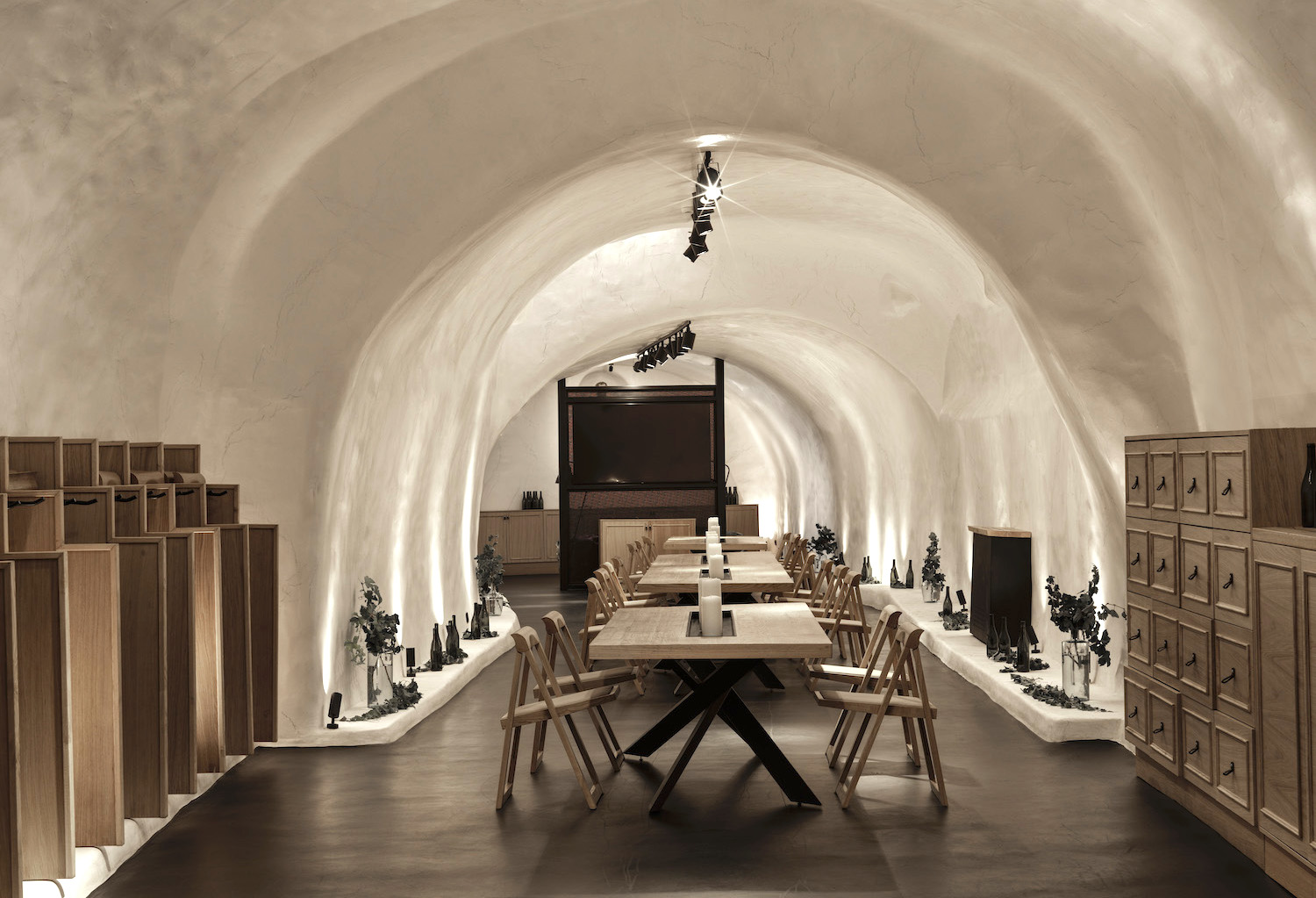
Entering the Caves
Selene’s Cuvée Privée can be sipped in the restaurant Selene Antique Caves, along with other signature wines that spotlight a host of Santorini’s best local grapes. “This is a reason on its own to visit the island,” Karakasis says. “The atmospheric Selene Wine Caves connect us with the wine traditions of the past as the wines of Santorini continue their fascinating journey in our era. We provide numerous wine tastings with every wine carefully selected to tell a story.”
During the upcoming high season, from May until October, Selene will also be hosting a series of events to celebrate the symbolic full moons of 2023. There, expertly-chosen labels will offer guests a unique tasting adventure, while plateaus of cheese and charcuterie will accompany the experience.
Other wine caves worth visiting in Santorini include Gavalas Winery — located in the Megalochori village — a family-run winery with unique wines you’d be hard pressed to find elsewhere on the island. A visit to Gavalas during harvest includes the possibility of experiencing the centuries-old practice of manually foot crushing the grapes. Vedema is a luxury hotel property which was originally a 400-year-old wine cellar, and Santorini is even home to one of the world’s only wine museums, Koutsoyannopoulos Winery and Wine Museum, which is located entirely underground.
For those who would rather sip their wine while admiring one of the island’s famed views, there are plenty of opportunities to do so. In Oia —which is known for its sunsets — dine at Michelin-starred Botrini’s Santorini or Katikies Santorini, where you can sit down for a dinner paired with wines chosen by Karakasis while overlooking the caldera.
Every Thursday, our resident experts see to it that you’re up to date on the latest from the world of drinks. Trend reports, bottle reviews, cocktail recipes and more. Sign up for THE SPILL now.
